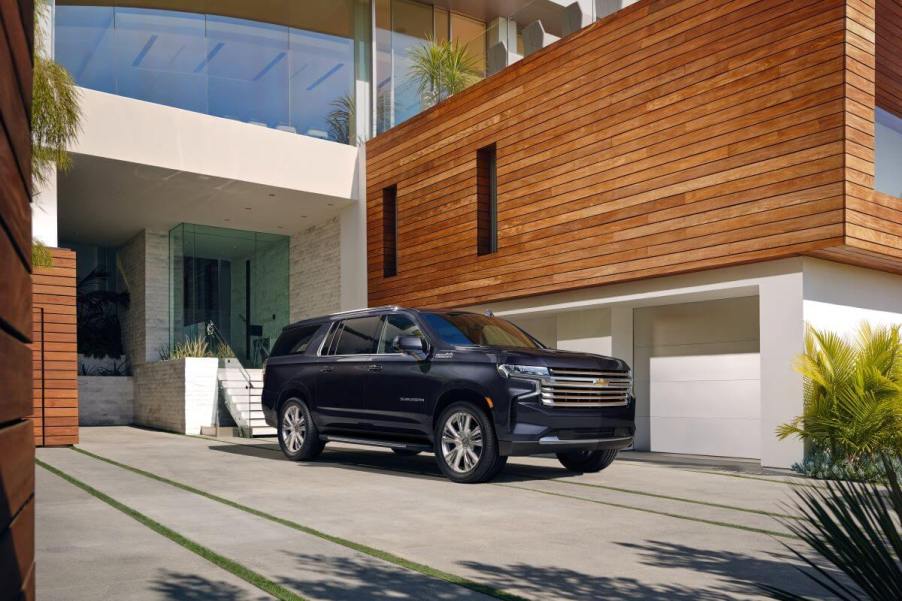
The Biggest Hit and Miss for the New Chevy Suburban
The Chevy Suburban has long been an American favorite in the auto industry. Having been first introduced to the Chevrolet lineup in 1935, no other American vehicle has been in continuous production longer than the Chevrolet Suburban.
In 2021, the 12th generation rendition of the Suburban was released. While still featuring the big metal box pickup frame, the 12th generation Suburban ditched the Silverado’s leaf-sprung solid axle in favor of multilink rear suspension, which undoubtedly provides a smoother ride and more passenger space. Of course, the 2024 Chevy Suburban is the latest rendition available from the 12th generation lineup. Here’s a look at the biggest hits and misses for the latest Suburban.
The biggest win for the Chevy Suburban is its massive interior
There’s simply no denying that the interior of the Chevy Suburban is absolutely massive. Its sheer size means it has more than enough room for a slew of passengers. According to Chevy, the Suburban can seat eight passengers while leaving plenty of room for everyone’s cargo. The maximum available cargo space listed is an impressive 144.7 cubic feet. With the interior space considered, it’s really no surprise that the Chevy Suburban was named “Best Large SUV for Families” by U.S. News for the past two consecutive years.
Its impressive interior isn’t the only win for the Chevrolet Suburban. The vehicle also provides excellent towing and hauling capacity. This SUV’s performance is hard to beat, delivering unapologetic power. As the manufacturer indicates, the Suburban possesses the power and torque to tow up to 8,300 lbs of cargo when properly equipped. According to Edmunds, the Suburban is available in six trim levels, including the LS, LT, RST, Z71, Premier, and High Country.
The Suburban leaves much to be desired in terms of fuel economy
While the Chevy Suburban isn’t the worst full-size SUV for fuel consumption, it’s certainly not the most fuel-efficient either. The Suburban only gets around 15 mpg in the city and around 20 mpg on the highway. However, consumers can opt to improve their fuel economy by upgrading their suburban to a diesel engine, providing 21 mpg in the city and 27 mpg on the highway, according to AutoTrader.
Along with its poor fuel economy, another key drawback of the Suburban is its restricted maneuverability. While its large size is great for hauling around friends, family, and cargo, its sheer size also restricts in-town maneuverability and limits parking options. So, you might find yourself having to park in the back of the parking lot or blocks away from your intended destination. At least it might help get your step count up! Additionally, the Suburban seems to fall short with its lack of safety features on lower-level trims and less than user-friendly interior controls.
Is the Chevrolet Suburban the right SUV for you?
There are definitely a ton of pros and cons associated with owning a Chevy Suburban. While it remains one of the best-selling SUVs in the U.S., that doesn’t mean it’s the right vehicle for all. If you’ve got a ton of kids or stuff to haul around, then the Suburban probably sounds like a great fit for your needs. However, if you value stellar fuel economy or frequently find yourself in the city, the Suburban probably shouldn’t be your first choice.
Some alternative compact SUVs include the Jeep Compass, GMC Terrain, Jeep Cherokee, Chevrolet Equinox, Toyota RAV4, and even the Ford Bronco Sport. Some additional options that are more on par with the size and performance of the Chevy Suburban include the likes of the GMC Yukon, Dodge Durango, Ford Expedition, or the Chevy Tahoe. While the Chevy Suburban has a lot to offer, it simply won’t fit the needs of all consumers.



